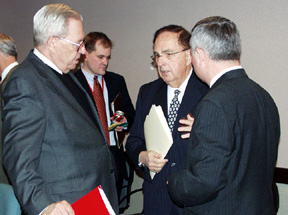 |
UNMC Chancellor Harold M. Maurer, M.D., visits with Donald A. Henderson, M.D., left, senior science advisor to the Secretary of Health and Human Services, and Nebraska Lt. Gov. David Heineman. UNMC scientist Paul Fey, Ph.D., is in the background. |
Dr. Henderson, senior science advisor to the Secretary of Health and Human Services, listened as university and state officials outlined Nebraska’s strategic strengths in the field, then he saw the mobile lab automation equipment that can process 1,000 specimens an hour and visited the Peter Kiewit Institute at the University of Nebraska at Omaha.
Dr. Henderson has extensive experience with public health diseases. He is internationally known for his work in public health and the eradication of smallpox around the world. Since Sept. 11, 2001, Dr. Henderson has worked to prepare the United States for any bioterrorism event involving weapons of mass destruction.
|
The Latta Lecture is named after the late John S. Latta, M.D. Dr. Latta taught courses in embryology and histology at UNMC from 1921 until 1963. Dr. Latta died in 1989 at age 94. |
“We are truly honored to have him visit campus and share his knowledge and insight in the fight against bioterrorism,” UNMC Chancellor Harold M. Maurer, M.D., said.
In all, 13 presenters informed Dr. Henderson about work being done in Nebraska on basic research related to bioterrorism agents, the state’s smallpox plan, the role of veterinary medicine and biotechnology applications for identifying microorganisms, among other topics.
University and state officials also detailed their plan for the National Emergency Preparedness Laboratory Center, which would augment the work of the Centers for Disease Control and Prevention.
Steven Hinrichs, M.D., director of the NU Center for Biosecurity and a UNMC faculty member, said that several factors make Omaha the best location, strategically, to house the facility that would augment the CDC’s work.
In addition to the expertise of several UNMC scientists, Omaha is a leading transportation center, with bisecting interstates and a major train hub; has fiber optic connectivity capability that is unmatched; is home to Offutt Air Force Base, from where U.S. presidents can link to key Defense personnel and other Cabinet members during wartime; is home to the world’s largest medical lab automation company, Lab-InterLink, which would provide for thorough and fast diagnostic testing during a disease outbreak; and has the support of its private community members.
Dr. Henderson directed the World Health Organization’s global smallpox eradication campaign (1966-1977). During this period, he founded the WHO Expanded Program on Immunization, which is now providing six vaccines to children throughout the world and which served to launch the global program for the eradication of poliomyelitis.